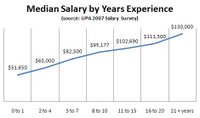My Take on Big Company Suckage
The individual is lost in the machine. The opportunity to be noticed, to get feedback for doing a job well, or for improving someone's life in or outside the company, is that much less. Which may limit your chance of a promotion, or just make you feel your job is pointless. One company I worked at had a famous management mantra, "If you're not making the product or selling it, what are you doing here?" Which is absolute bullshit, and dismisses the administrative roles of accounting, the benefits department, travel and admin staff, tech support, and other critical team members at a large software business. Functional companies need a lot of people doing different things, otherwise the people writing the code can't do THAT job.
Communication from the top is often poor, intentionally or not. The message that trickles down from management, or that's delivered from main stage at company meetings, tends to be diluted for the common denominator, which means it's not really addressed to anyone in particular. Sometimes it contains no information at all, as a result. Scott may have covered this under "they believe their own bullshit," but I think there's another slant on it: They don't know what's going on. The more levels and divisions there are, the more distorted the signal is, and the more likely you are to hit people who aren't sure they're supposed to be telling you something that they know.
Secretiveness. I don't get it - but bigger companies tend to keep more secrets from their own employees. I have nothing to say about this right now, because I'm just baffled by it.
Managers are rarely evaluated well or fairly at any sized company. Even in times of turnover or economic distress, management are the last to go (unless they're a very public, board-threatened figure, like a CEO, in a very bad political environment). Scott mentioned the Peter Principle, but I think it's more profound -- with power working as sum of the people below you, the weakest point in the tree is the bottom. Even when the bottom is arguably the most valuable part of the workforce. Companies with a lot of management structure will have fewer people doing quantifiably good work, occupying the org chart and protecting themselves at the expense of the workers under them.
Evaluation of what's good or valuable often happens on idiotic scales. When I worked at AT&T Labs 15 years ago, the company didn't think about anything but a sure business that would pull in billions -- never mind betting on smaller startup ideas to see if they could create new markets or businesses. Other companies like 3M and Google have since made this a visibly stupid way to do business, but it's definitely an easy way that managers can avoid risky bets on new verticals or product lines.
The small company made crap, and now the big company has to support it. Staff in big companies are sometimes stuck in trying to repair what was made by the small company, or what was acquired from the small company. This really sucks for the people in the big company. Bad design that was produced in a "proof of concept prototype" as VC's pounded on the door and the cash ran out -- well, those guys saying the good old days were great got rich off that crap, and now it's everyone else's job to "fix it."
Because the small company made so many mistakes, and the bigger company learned from them, there is more process and review of decisions. Face it - a lot of the processes and checks and balances in bigger companies exist because of bad things that happened when the company was smaller. The big company "learned." It decided it was too risky to do that stuff again. Stuff like having no usability review of the most important feature of the release!
Smaller companies sometimes feel more homogeneous -- the individuals know each other better, and there's usually less role differentiation and processes involving a lot of people you don't understand. This can make it more pleasant, give the impression that you're "getting things done," but it can also mean less original or high quality work is produced in the end. See above, about producing crap and making mistakes.
People who have their own money at stake, or make a lot of money from something they did, tend to be very engaged and happier about their contribution. This is a guess, but I think this study about hourly workers supports it. The study says people feel a stronger correlation between happiness and rate when they are paid hourly, rather than by salary. There's a direct reward connection between money and time. People who got a lot of money from a startup --either from selling one, or being there and getting the stock profits -- no doubt feel they were rewarded by the world for something of value that they did. It's less easy to feel rewarded either monetarily or by subjective feeling in a big company. Because the individual contribution is much harder to make or to recognize.
Finally, a few ways in which small companies can suck, too: There's never enough money, or for long enough; there isn't enough staff to do things that need doing (travel booking, accounting, etc?); the hours can really suck, related to the money issue, no doubt; there are STILL cowboy coders and often secret politics about decisions and design directions and what we're hiring for next.
Labels: management









